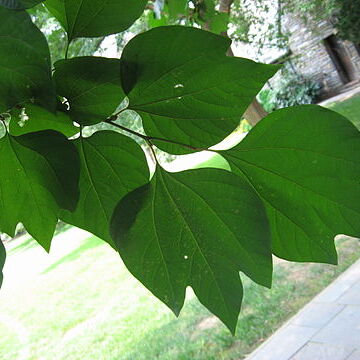Deciduous trees or shrubs, 3-10 m tall. Bark black-brown. Branchlets yellow-green, smooth and striate when young, brown scurfy, longitudinally dehiscent, and corky lenticellate when old. Buds ovate, apex acuminate; outer bud scales 3, yellow-brown, elliptic, 6-9 × 6-7 mm, leathery, glabrous, acute at apex; inner bud scales 3, very densely brownish yellow sericeous; sometimes mixed budded, including leaf buds and floral buds. Leaves alternate; petiole 1.5-2.8 cm, yellow-white pubescent; leaf blade pale greenish or sometimes red abaxially, dark green adaxially, suborbicular, compressed-rounded, or elliptic, 5.5-10 × 4.8-10.8 cm, brown-yellow pubescent or glabrate abaxially, trinerved, sometimes pentanerved, reticulate veins distinct, base broadly cuneate, subrounded, rounded, cordate, or subcordate, margin usually entire, sometimes emarginate or wavy, or usually trifid and sometimes pentafid, apex acute or rounded. Mixed buds axillary, elliptic, acute at apex, outer 2 bud scales leathery, brown-yellow, rugose, glabrous, inner bud scales subleathery, adnate-pubescent, with 1 or 2 floral buds inside; floral bud 5 or 6, umbels included. Umbels not pedunculate, with 4 involucral bracts; involucral bracts narrowly elliptic, membranous, villous outside, glabrous inside, 5 flowers included. Male flowers: tepals 6, narrowly elliptic, villous outside and glabrous inside; stamens 9; filaments glabrous, 2-glandular at base in 3rd whorl; glands broadly reniform, cornute, long stipitate, sometimes 1 at filament base in 2nd whorl; reduced pistil narrowly elliptic, glabrous; style and stigma forming a mucro. Female flowers: tepals 6, narrowly elliptic, ca. 2.5 × 1 mm, slightly short in inner whorl, villous on dorsal keel, glabrous inside; reduced stamens fasciated, ca. 1.7 mm in 1st and 2nd whorls, ca. 1.5 mm in 3rd whorls, 2-glandular at filament base; glands long stipitate; stipe base and filament base coadnate; ovary ellipsoid, ca. 2.2 × 1 mm, glabrous; style less than 1 mm, curved downward before bloom. Fruits broadly ellipsoid, ca. 8 × 5-6 mm, red at maturity, later purple-black, black-brown when dry. Fl. Mar-Apr, fr. Aug-Sep.
More
A spreading deciduous shrub or small tree. It can grow 9 m tall. The branches are grey-yellow and can be flushed with purple. The leaves can have smooth edges or have 3 lobes. The leaves turn golden in autumn. The flowers are small and star-shaped. They are green-yellow and crowded in groups on the previous years growth. The fruit are glossy and dark red to black.


